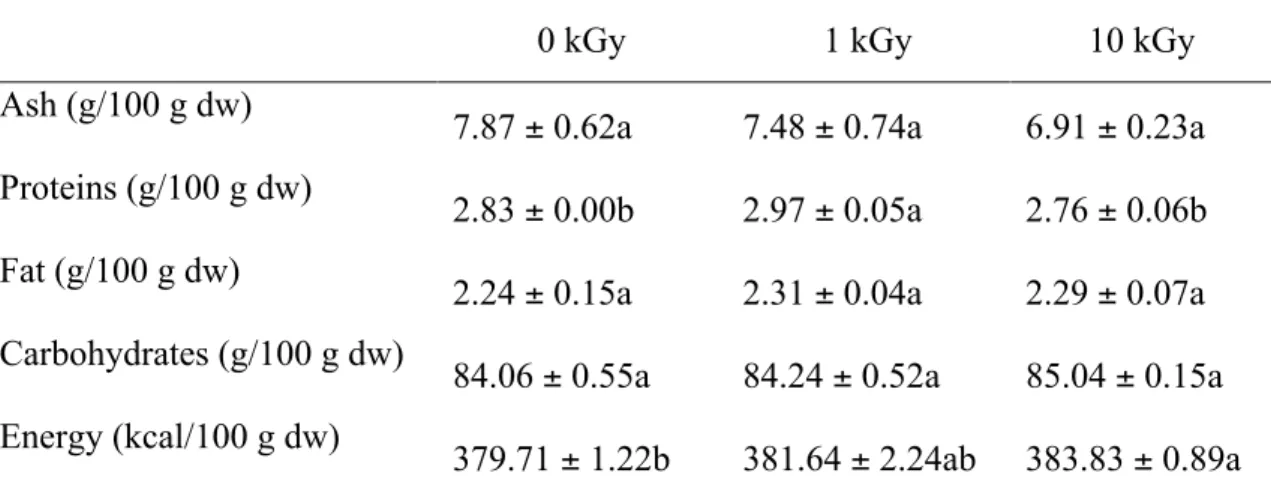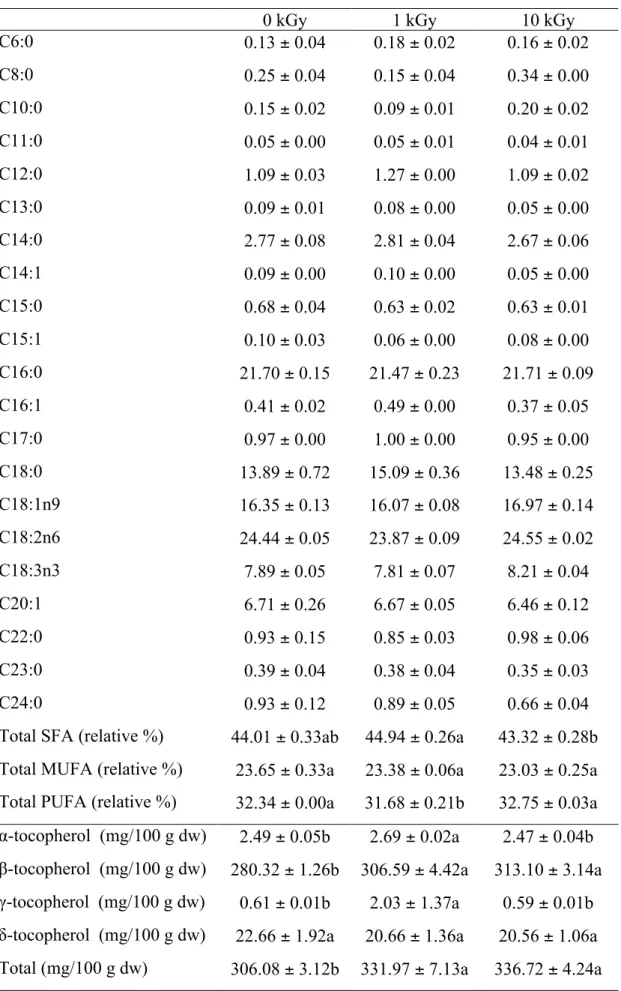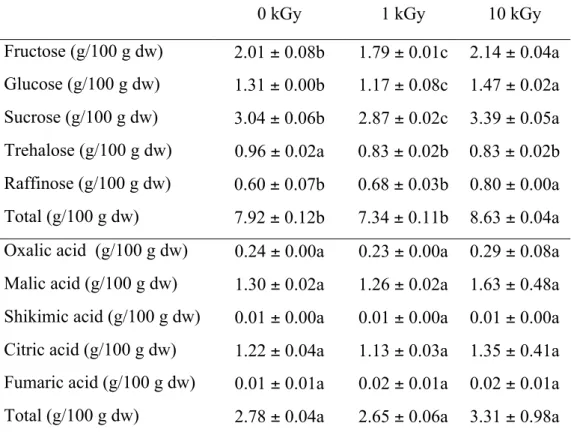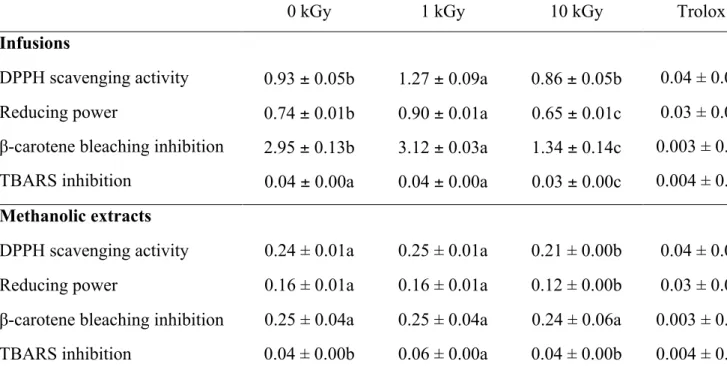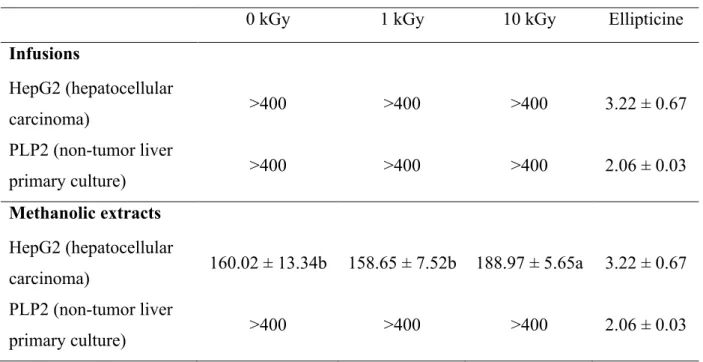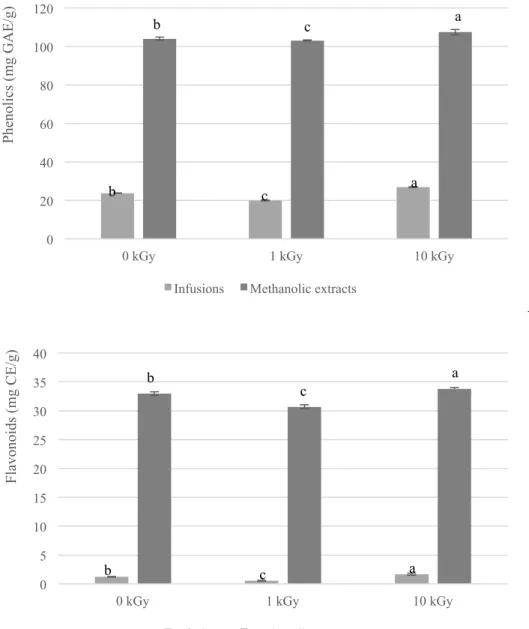Effects of gamma radiation on chemical and antioxidant properties,
anti-hepatocellular carcinoma activity and hepatotoxicity of borututu
Carla Pereiraa, Ricardo C. Calhelhaa,b, Amilcar L. Antonioa,c, Maria João R.P. Queirozb, Lillian Barrosa,*, Isabel C.F.R. Ferreiraa,*
a
Centro de Investigação de Montanha (CIMO), ESA, Instituto Politécnico de Bragança, Campus de Santa Apolónia, apartado 1172, 5301-855 Bragança, Portugal
b
Centro de Química, Universidade do Minho, Campus de Gualtar 4710-057 Braga, Portugal
c
Centro de Ciências e Tecnologias Nucleares, Universidade de Lisboa, Estrada Nacional 10, 2686-953 Sacavém, Portugal
ABSTRACT
Borututu is a well-known medicinal plant in Angola for the treatment of liver diseases and for the prophylaxis of malaria. Our research group reported, in a recent study, that its infusion, pills and syrups display significant antioxidant and anti-hepatocellular carcinoma activities. However, during the processing and storage, it can be easily exposed to contamination that can lead to a microbial deterioration or insect infestation compromising its quality, shelf life, and efficiency. Herein, we investigated the effect of gamma irradiation, one of the most promising decontamination methods for many foodstuffs and plant materials, at different doses (1 and 10 kGy) on borututu regarding to its nutritional value, lipophilic (fatty acids and tocopherols) and hydrophilic (free sugars and organic acids) compounds, antioxidant and anti-hepatocellular carcinoma activities. In general, the irradiation treatment did not appreciably affect the nutritional value of the studied plant, but the highest energetic contribution (383.83 kcal/100 g), total sugars (8.63 g/100 g), organic acids (3.31 g/100 g dw), total tocopherols (336.72 mg/100 g dw), and PUFA (32.75%) contents were found in the sample irradiated at 10 kGy. Furthermore, this sample presented also the highest levels of total phenolics and flavonoids and, in general, the highest antioxidant activity (EC50 values of 0.04 to 0.24 mg/mL for the methanolic extract and 0.03 to 1.34 mg/mL for the infusion). Irradiated samples kept the anti-hepatocellular carcinoma activity, but a decrease was observed in the methanolic extract prepared from sample irradiated at 10 kGy (GI50=188.97 µg/mL). Overall, gamma irradiation proved to be a suitable technique of preservation of dried herbs without affecting the bioactive compounds.
1. Introduction
Cochlospermum angolensis Welw. (borututu) is a widespread medicinal plant in Angola, where the barks infusion has been traditionally used by healers for the treatment of many liver diseases and for the prophylaxis of malaria (Poppendieck, 1981; Presber, Herrman, & Hegenscheid, 1991; Silva et al., 2011). Recently, our research group reported that the infusion, pills (Pereira, Calhelha, Barros, & Ferreira, 2013) and syrups (Pereira, Calhelha, Barros, Queiroz, & Ferreira, 2014) of the dry barks display significant antioxidant and anti-hepatocellular carcinoma activities.
However, raw materials from medicinal plants are easily exposed (from the plants themselves, the soil, water, air and dust) to contamination with pathogens during the harvest or the air drying time, and the storage in dried form during long periods, which can lead to a microbial deterioration or insect infestation that decrease herbs quality and shelf life, compromising their efficiency and even posing a public health threat (Rosa, Medina, & Vivar, 1995; Pal et al., 2010). This kind of contamination, particularly with pathogenic non-spore forming, is one of the most significant causes of human suffering all over the world, and according to World Health Organisation (WHO), the infectious and parasitic diseases represented the most frequent cause of death (35%) worldwide (Loaharanu, 1994; Khan & Abrahem, 2010). Therefore, to improve the hygienic quality and guarantee the stability of active compounds of the plant materials during storage, making it suitable for human use and commercialization, an adequate technology for decontamination is required (Katusin-Razem, 2001; Thomas, Senthilkumar, Kumar, Mandal, & Muraleedharan 2008; Bhat, Sridhar, & Karim,2010).
or methyl bromide for decontamination or sterilization, that are carcinogenic and increasingly restricted in several countries, due to health, environmental or occupational safety reasons. Among the different types of radiation sources allowed for food processing (gamma, X-ray, UV, electron beam), gamma irradiation represents an effective and environment friendly technology to avoid the contamination and re-infestation of the product, since it can be done after packaging (Khattak, Simpson, & Ihasnullah, 2009; Aouidi, Samia, Hana, Sevastianos, & Moktar, 2011). This treatment has been carried out in several plant species and the doses used should guarantee consumer safety without compromising wholesomeness, structural integrity, functional properties, or sensory attributes, being often between 2 and 30 kGy (Olson, 1998; Khan & Abrahem, 2010).
Nevertheless, as far as we know, no studies have been performed on borututu irradiated dry barks. The typical doses for insects disinfestation or parasite inactivation are up to 1 kGy and to reduce or eliminate spoilage or disease causing pathogenic microorganisms the common doses used are up to 10 kGy (Molins, 2001). Therefore, this study was undertaken to investigate the effect of different doses of gamma irradiation (1 and 10 kGy) on this plant regarding to its macronutrients composition, lipophilic (fatty acids and tocopherols) and hydrophilic compounds (free sugars and organic acids). Furthermore, due to its benefits in the prevention/treatment of liver diseases, the irradiated plant infusion and methanolic extract were also assessed to evaluate their antioxidant and anti-hepatocellular carcinoma activity depending on the different radiation doses.
2.1. Samples and samples irradiation
Cochlospermum angolensis Welw. (borututu) was obtained from an herbalist shop, Américo Duarte Paixão Lda., in Alcanede (Portugal), imported from Angola, as dry barks material (the taxonomical identification of the plant species mentioned in the label was confirmed). The samples were divided into three groups: control (non-irradiated, 0 kGy), sample irradiated at 1 kGy, and sample irradiated at 10 kGy, where 1 kGy and 10 kGy were the predicted doses.
The irradiation of the samples was performed in a Co-60 experimental chamber (Precisa 22, Graviner Manufacturing Company Ltd., UK) with four sources, total activity 177 TBq (4.78 kCi), in September 2013, and the estimated dose rate for the irradiation position was obtained with Fricke dosimeter. During irradiation process, the dose was estimated using Amber Perspex routine dosimeters (batch V, from Harwell Company, UK), following the procedure previously described by Fernandes et al. (2013). The estimated doses, dose rates and dose uniformity ratios (Dmax/Dmin) were, respectively: 1.20 ± 0.07 kGy, 2.57 ± 0.15 kGy h–1, 1.20 for sample irradiated at 1 kGy and 8.93 ± 0.14 kGy, 1.91 ± 0.03 kGy h–1, 1.02 for sample irradiated at 10 kGy. For simplicity, in the text and tables we considered the values 0, 1 and 10 kGy, for the doses of non-irradiated and non-irradiated samples 1 and 2, respectively.
After irradiation, the samples were reduced to a fine dried powder (20 mesh) using a grinding mill, and mixed to obtain homogenized samples for subsequent analysis or preparation of infusions/extracts.
2.2. Standards and reagents
the standards (ASTM, 1992) and Amber Perspex dosimeters (batch V, from Harwell Company, UK). To prepare the acid aqueous Fricke dosimeter solution the following reagents were used: ferrous ammonium sulfate(II) hexahydrate, sodium chloride and sulfuric acid, all purchased from Panreac S.A. (Barcelona, Spain) with purity PA (proanalysis), and water treated in a Milli-Q water purification system (Millipore, model A10, Billerica, MA, USA).
For chemical analyses: Acetonitrile 99.9%, n-hexane 95% and ethyl acetate 99.8% were of HPLC grade from Fisher Scientific (Lisbon, Portugal). Fatty acids methyl ester (FAME) reference standard mixture 37 (standard 47885-U) was purchased from Sigma (St. Louis, MO, USA), as also were other individual fatty acid isomers, L-ascorbic acid, tocopherol, sugar and organic acid standards. Racemic tocol, 50 mg/mL, was purchased from Matreya (Pleasant Gap, PA, USA).
For antioxidant activity evaluation: 2,2-diphenyl-1-picrylhydrazyl (DPPH) was obtained from Alfa Aesar (Ward Hill, MA, USA). Trolox (6-hydroxy-2,5,7,8-tetramethylchroman-2-carboxylic acid) was from Sigma (St. Louis, MO, USA).
For anti-hepatocellular carcinoma activity and hepatotoxicity evaluation: ellipticine, phosphate buffered saline (PBS), acetic acid, sulforhodamine B (SRB), trichloroacetic acid (TCA) and Tris were purchased from Sigma (St. Louis, MO, USA). Foetal bovine serum (FBS), L-glutamine, Hank’s balanced salt solution (HBSS), trypsin-EDTA (ethylenediaminetetraacetic acid), nonessential amino acids solution (2 mM), penicillin/streptomycin solution (100 U/mL and 100 mg/mL, respectively) and DMEM (Dulbecco's Modified Eagle Medium) were from Hyclone (Logan, Utah, USA).
2.3. Chemical composition 2.3.1. Nutritional value
Protein, fat, carbohydrates and ash were determined following the AOAC procedures (AOAC, 1995). The samples crude protein content (N×6.25) was estimated by the Kjeldahl method; the crude fat was determined using a Soxhlet apparatus by extracting a known weight of sample with petroleum ether; the ash content was determined by incineration at 600±15 °C. Total carbohydrates were calculated by difference and total energy was calculated according to the following equations: Energy (kcal)=4×(g protein+g carbohydrates)+9×(g fat).
2.3.2. Lipophilic compounds
Fatty acids. Fatty acids were determined after a lipid extraction of the sample (3 g) using a Soxhlet apparatus with petroleum ether; afterwards a transesterification procedure was applied to the lipid extract as described previously by the authors (Barros et al., 2013a), using a gas chromatography equipment (DANI 1000), with a split/splitless injector and a flame ionization detector (GC-FID). Fatty acid identification was made by comparing the relative retention times of FAME peaks from samples with standards. The results were recorded and processed using CSW 1.7 software (DataApex 1.7). The results were expressed in relative percentage of each fatty acid.
Germany), degasser system (Smartline manager 5000) and auto-sampler (AS-2057 Jasco, Easton, MD, USA), coupled to a fluorescence detector (FP-2020; Jasco) programmed for excitation at 290 nm and emission at 330 nm. The compounds were identified by chromatographic comparisons with authentic standards. Quantification was based on the fluorescence signal response of each standard, using the IS (tocol) method and by using calibration curves obtained from commercial standards of each compound: α-tocopherol (y=1.295x; R2=0.991); β-tocopherol (y=0.396x; R2=0.992); γ -tocopherol (y=0.567x; R2=0.991); δ-tocopherol (y=0.678x; R2=0.992). The results were expressed in mg per 100 g of dry weight.
2.3.3. Hydrophilic compounds
Sugars. Free sugars were determined following a procedure previously optimized and described by the authors (Barros et al., 2013a). Analysis was performed by HPLC (equipment described above) coupled to a refraction index detector (RI detector Knauer Smartline 2300, Berlin, Germany). Sugars identification was made by comparing the relative retention times of sample peaks with standards. Data were analyzed using Clarity 2.4 Software (DataApex). Quantification was based on the RI signal response of each standard, using the internal standard (IS, raffinose) method and by using calibration curves obtained from commercial standards of each compound: fructose (y=0.864x; R2=0.999); glucose (y=0.909x; R2=0.999); sucrose (y=0.892x; R2=0.999); trehalose (y=0.953x; R2=0.999); raffinose (y=0.847x; R2=0.999). The results were expressed in g per 100 g of dry weight.
was performed by ultra fast liquid chromatograph (UFLC) coupled to photodiode array detector (PDA), using a Shimadzu 20A series UFLC (Shimadzu Corporation, Kyoto, Japan). Detection was carried out in a PDA, using 215 nm and 245 as preferred wavelengths. The organic acids were quantified by comparison of the area of their peaks recorded at 215 nm with calibration curves obtained from commercial standards of each compound: citric (y=1E+06x+4170.6; R2=1); fumaric acid (y=172760x+52193; R2=0.999); malic acid (y=952269x+17803; R2=1); oxalic acid (y=1E+07x+96178; R2=0.999); shikimic acid (y=9E+07x-95244; R2=1). The results were expressed in g per 100 g of dry weight.
2.4. Preparation of the extracts for the bioassays
Infusions (water extracts). A dry weight of each sample of borututu (2 g) was added to 200 mL of boiling distilled water, left to stand at room temperature for 5 min, and filtered through Whatman No. 4 paper. The following dilutions were used in the biological assays: 5 mg/mL to 19.53 µg/mL for antioxidant activity assays; 400 to 1.56
µg/mL for hepatotoxicity assays.
Methanolic extracts. The different samples of borututu (1 g) were stirred with methanol (30 mL) at 25 °C at 150 rpm for 1 h and filtered through Whatman No. 4 paper. The residue was then extracted with an additional portion of methanol. The combined methanolic extracts were evaporated under reduced pressure (rotary evaporator Büchi R-210; Flawil, Switzerland), re-dissolved in methanol at 10 mg/mL (stock solution), and stored at 4 °C for further use. Successive dilutions were made from the stock solution at the same concentrations as described for the infusions.
2.5.1 General. The infusion (water extract) and methanolic extract were redissolved in i) water and methanol, respectively (final concentration 2.5 mg/mL) for antioxidant activity evaluation, or ii) water for antitumor activity evaluation (final concentration 8 mg/mL). The final solutions were further diluted to different concentrations to be submitted to distinct bioactivity evaluation in vitro assays. The results were expressed in i) EC50 values (sample concentration providing 50% of antioxidant activity or 0.5 of absorbance in the reducing power assay) for antioxidant activity, or ii) GI50 values (sample concentration that inhibited 50% of the net cell growth) for antitumor activity. Trolox and ellipticine were used as standards in antioxidant and antitumor activity evaluation assays, respectively.
2.5.2. Quantification of total bioactive compounds. Total phenolics were estimated by Folin-Ciocalteu colorimetric assay according to procedures previously described (Sarmento et al., 2014); the results were expressed as mg of gallic acid equivalents (GAEs) per g of infusion and methanolic extract. Total flavonoids were determined by a colorimetric assay using aluminum trichloride, following procedures previously reported (Sarmento et al., 2014); the results were expressed as mg of catechin equivalents (CE) per g of infusion and methanolic extract.
2.5.3. Antioxidant activity.DPPH radical-scavenging activity was evaluated by using an ELX800 microplate reader (Bio-Tek Instruments, Inc; Winooski, VT, USA), and calculated as a percentage of DPPH discolouration using the formula: [(ADPPH
-AS)/ADPPH] × 100, where AS is the absorbance of the solution containing the sample at
in the microplate reader mentioned above. Inhibition of β-carotene bleaching was
evaluated though the β-carotene/linoleate assay; the neutralization of linoleate free
radicals avoids β-carotene bleaching, which is measured by the formula: β-carotene
absorbance after 2h of assay/initial absorbance) × 100. Lipid peroxidation inhibition in porcine (Sus scrofa) brain homogenates was evaluated by the decreasing in thiobarbituric acid reactive substances (TBARS); the colour intensity of the malondialdehyde-thiobarbituric acid (MDA-TBA) was measured by its absorbance at 532 nm; the inhibition ratio (%) was calculated using the following formula: [(A - B)/A]
× 100%, where A and B were the absorbance of the control and the sample solution, respectively (Fernandes et al., 2014).
2.5.4. Anti-hepatocellular carcinoma activity and hepatotoxicity
The anti-hepatocellular carcinoma activity was evaluated using HepG2, which is the most widely used tumor cell line and generally regarded as a good hepatocellular carcinoma model. HepG2 cells were routinely maintained as adherent cell cultures in DMEM supplemented with 10% FBS, 2 mM glutamine, 100 U/mL penicillin and 100 mg/mL streptomycin, at 37 ºC, in a humidified air incubator containing 5% CO2. The cell line was plated at 1.0 × 104 cells/well in 96-well plates. Sulforhodamine B assay was performed according to a procedure previously described by the authors (Barros et al., 2013a).
in 96-well plates at a density of 1.0×104 cells/well, and commercial in DMEM medium with 10% FBS, 100 U/mL penicillin and 100 µg/mL streptomycin.
2.6. Statistical analysis
Three samples were used for each preparation and all the assays were carried out in triplicate. The results are expressed as mean values and standard deviation (SD). The results were analyzed using one-way analysis of variance (ANOVA) followed by Tukey’s HSD Test with α = 0.05. This treatment was carried out using SPSS v. 18.0 program (SPSS Inc.).
3. Results and Discussion
3.1. Chemical composition
Results regarding chemical composition of the control (non-irradiated) and irradiated samples are present in Tables 1-3. Nutritionally, all borututu samples revealed similar profiles (Table 1), with the exception of protein content; the remaining nutritional parameters did not reveal significant variation between irradiated and control samples. The protein content clearly decreased with the increasing irradiation dose, being the highest values presented by sample irradiated at 1 kGy (2.97 g/100 g), which is in agreement with a previous study that reported the effects of gamma irradiation in the disruption of the ordered structure and the degradation and aggregation of the polypeptide chains of proteins, due to oxygen radicals generated by irradiation (Moon & Song, 2001).
fatty acids in all samples were linoleic (C18:2n6; 23.87-24.55%) and palmitic acid (C16:0; 21.47-21.71%), which is in agreement with a previous study performed by our research group (Pereira et al., 2014a). Among the three samples, sample irradiated at 1 kGy gave lower percentage of PUFA (32.75%) and SFA (43.32%), while control and sample irradiated at 10 kGy revealed quite similar amounts. Significant differences were not observed between the MUFA percentages of the studied sample. It was previously reported that unsaturated fatty acids, especially n-3 PUFAs, play an important role in the treatment or prevention of hepatic steatosis (Hanke, Zahradka, Mohankumar, Clark, & Taylor, 2013). Being borututu consumed essentially for hepatic purposes, it is important to keep those fatty acids after irradiation and, in fact, the sample irradiated with 10 kGy revealed the same levels in relation to control.
Regarding free sugars, and also in concordance with Pereira et al. (2014a), fructose and sucrose were the most abundant molecules. As observed in Table 3, 1 kGy (sample 1) was not enough to preserve sugars content, where it was verified a decrease of fructose, glucose, sucrose, and trehalose. On the contrary, sample irradiated at 10 kGy showed the highest amount of these sugars that also contributed to the highest total sugars content (8.63 g/100 g). This is in agreement with previous works with irradiated plants that explained this increase through the depolymerization or degradation of polysaccharide molecules and glucoside group due to gamma irradiation in soybeans (Byun, Kang, & Mori, 1996) and ginseng products (Sung, Park, Lee, & Cho, 1982).
Tissot, Grdanovska, Barkatt, Silverman, & Al-Sheikhly (2013) also reported the potential of ionizing radiation on facilitating the breakdown of cellulose into simple sugars.
bacteria; on the other hand, fumaric acid is an important parameter to reveal microbial spoilage or processing of decayed food, and the naturally occurring concentration of some organic acids in plants can give information about the addition of synthetic preservatives to plant products, providing evidences of eventual authenticity issues (Gebre, Kuhns, & Brandle, 1994; Vaughan & Geissler, 1997).
3.2. Antioxidant properties, anti-hepatocellular carcinoma activity and hepatotoxicity Four in vitro assays were used to evaluate antioxidant properties of infusions and methanolic extracts of the samples: scavenging effects on DPPH radicals, reducing power, inhibition of β-carotene bleaching and inhibition of lipid peroxidation in brain cell homogenates. As shown in Table 4, the infusion obtained from the sample irradiated at 10 kGy had a higher antioxidant activity in all the assays performed, with no statistical differences in the DPPH scavenging effect when compared to the control sample. On the other hand, the methanolic extract of this sample gave higher DPPH radicals scavenging activity and reducing power, and similar β-carotene bleaching and the lipid peroxidation inhibitions. Still, the methanolic extracts revealed higher scavenging activity, reducing power and β-carotene bleaching inhibition than the infusion. The latest can be compared with the infusion of borututu assessed in a previous study (Pereira et al., 2013) where it revealed antioxidant properties in lower concentrations (0.02-0.62 mg/mL). These data are also in accordance with a previous study where the ethanolic extracts revealed better results than the corresponding infusions prepared from irradiated Korean medicinal herbs (Byun et al., 1999).
soybean fermented foods (Byun, Son, Yook, Jo, & Kim, 2002), in the present work the results obtained are in agreement with Kim et al. (2009) that revealed that the DPPH radical scavenging activity of gamma irradiated Hizikia fusiformis extracts were increased with increasing irradiation dose, which was related to the increase of the total polyphenolic compounds content by the irradiation. Similarly to the referred observations, in the present study the total phenolics and flavonoids content in the 10 KGy irradiated sample was higher in both extracts, with respectively 26.85 mg GAE/g and 1.68 mg CE/g in the infusion, and 107.45 mg GAE/g and 33.77 mg CE/g in the methanolic extract, leading to a better understanding of the results discussed above. The anti-hepatocellular carcinoma activity and hepatotoxicity of the infusions and methanolic extracts prepared from the three samples was also evaluated and the results are present in Table 5. All the methanolic extracts revealed anti-hepatocellular carcinoma activity that clearly decreased in the sample irradiated at 10 kGy (GI50=188.97 µg/mL) relatively to the control sample (GI50=160.02 µg/mL). Nevertheless, the infusions did not reveal anti-hepatocellular carcinoma activity in opposition to the results obtained in the mentioned previous work (Pereira et al., 2013), where the infusion revealed this capacity with a GI50 value of 146.06 µg/mL. This discrepancy, as those reported throughout the present discussion of results, can be explained by the kind of material analysed, once in the referred work a preparation for infusion was acquired while in the present study it was used bulk borututu, from another supplier. Moreover, the bioactivity of medicinal plants depends on numerous factors beyond the species, namely the origin of the sample, making it impossible to guarantee chemical homogeneity.
In conclusion, irradiation treatment up to 10 kGy does not appreciably affect the nutritional value of the studied plant, which can be explained by the low water content of dry herbs that limits the possibility of the formation of free radicals (Venskutonis, Poll, & Larsen, 1996; Murcia et al., 2004; Brandstetter, Berthold, Isnardy, Solar, &
Elmadfa, 2009). In fact, sample irradiated at 10 kGy had the highest energetic contribution and the highest levels of total sugars, organic acids, total tocopherols, and PUFA. According to the results obtained for the antioxidant activity assays, the risk of limiting antioxidative properties of dried borututu due to the irradiation at the tested doses can be excluded, with sample irradiated at 10 kGy revealing, in general, the highest properties. Regarding to the anti-hepatocellular carcinoma activity, irradiated samples kept the activity, but a decrease was observed in the methanolic extracts prepared from sample irradiated at 10 kGy. Gamma irradiation proved to be a suitable technique to maintain bioactive compounds and effects of borututu (a widely used dried plant).
Acknowledgements
The authors thank Clarinda Paixão, from Américo Duarte Paixão Lda, for samples providing.
References
AOAC. (1995). Official methods of analysis, 16th ed. Arlington VA, USA. Association of Official Analytical Chemists
antioxidative properties and on phenolic compounds. Food Chemistry, 127, 1105-1113.
ASTM, American Society for Testing and Materials. (1992). Practice for Using the Fricke Reference Standard Dosimetry System, ASTM E1026. Annual Book of ASTM Standards, 12.02, Philadelphia, PA.
Barros, L., Pereira, E., Calhelha, R.C., Dueñas, M., Carvalho, A.M., Santos-Buelga, C., & Ferreira, I.C.F.R. (2013a). Bioactivity and chemical characterization in hydrophilic and lipophilic compounds of Chenopodium ambrosioides L. Journal of Functional Foods, 5, 1732-1740.
Barros, L., Pereira, C., & Ferreira, I.C.F.R. (2013b). Optimized analysis of organic acids in edible mushrooms from Portugal by ultra fast liquid chromatography and photodiode array detection. Food Analytical Methods, 6, 309-316.
Bhat, R., Sridhar, K.R., & Karim, A.A. (2010). Microbial quality evaluation and effective decontamination of nutraceutically valued lotus seeds by electron beams and gamma irradiation. Radiation Physics and Chemistry, 79, 976-981.
Brandstetter, S., Berthold, C., Isnardy, B., Solar, S., & Elmadfa, I. (2009). Impact of gamma-irradiation on the antioxidative properties of sage, thyme, and oregano. Food and Chemical Toxicology, 47, 2230-2235.
Byun, M.W., Kang, I.J., & Mori, T. (1996). Effect of γ-irradiation on the water soluble components of soybeans. Radiation Physics and Chemistry, 47, 155-160.
Byun, M.W., Son, J.H., Yook, H.S., Jo, C., & Kim, D.H. (2002). Effect of gamma irradiation on the physiological activity of Korean soybean fermented foods, Chungkookjang and Doenjang. Radiation Physics and Chemistry, 64, 245-248. Fernandes, Â., Antonio, A.L., Barreira, J.C.M., Botelho, L., Oliveira, M.P.P., Martins,
A., & Ferreira, I.C.F.R. (2013). Effects of gamma irradiation on the chemical composition and antioxidant activity of Lactarius deliciosus L. wild edible mushroom. Food and Bioprocess Technology, 6, 2895-2903.
Fernandes, Â., Antonio, A.L., Barros, L., Barreira, J.C.M., Bento, A., Botelho, M.L., & Ferreira, I.C.F.R. (2011). Low Dose γ-Irradiation as a suitable solution for chestnut (Castanea sativa Miller) conservation: effects on sugars, fatty acids, and tocopherols. Journal of Agricultural and Food Chemistry, 59, 10028-10033. Fernandes Â., Barreira, J.C.M., Antonio, A.L., Santos, P.M.P., Martins, A., Oliveira,
M.B.P.P., Ferreira I.C.F.R. (2013). Study of chemical changes and antioxidant activity variation induced by gamma-irradiation on wild mushrooms: comparative study through principal component analysis. Food Research International, 54, 18-25.
Fernandes, Â., Barreira, J.C.M., Antonio, A.L., Oliveira, M.B.P.P., Martins, A., & Ferreira, I.C.F.R. (2014). Feasibility of electron-beam irradiation to preserve wild dried mushrooms: effects on chemical composition and antioxidant activity. Innovative Food Science and Emerging Technologies, doi 10.1016/j.ifset.2013.12.015.
Hanke, D., Zahradka, P., Mohankumar, S.K., Clark, J.L., & Taylor, C.G. (2013). A diet high in α-linolenic acid and monounsaturated fatty acids attenuates hepatic steatosis and alters hepatic phospholipid fatty acid profile in diet-induced obese rats. Prostaglandins, Leukotrienes & Essential Fatty Acids, 89, 391-401.
Khan, A.K., & Abrahem, M. (2010). Review Article. Effect of irradiation on quality of spices. International Food Research Journal, 17, 825-836.
Khattak, K.F., Simpson, T.J., & Ihasnullah. (2009). Effect of gamma irradiation on the microbial load, nutrient composition and free radical scavenging activity of Nelumbonucifera rhizome. Radiation Physics and Chemistry, 78, 206-212.
Katusin-Razem, B., Novak, B., & Razem, D. (2001). Microbiological decontamination of botanical raw materials and corresponding pharmaceutical products by irradiation. Radiation Physics and Chemistry, 62, 261-275.
Kim, H.J., Choi, J., Kim, D.J., Kim, J.H., Chun, B.S., Ahn, D.H., Yook, H.S., Byun, M.W., Kim, M.J., Shin, M.G., & Lee, J.W. (2009). Effect of ionizing radiation on the physiological activities of ethanol extract from Hizikia fusiformis cooking drips. Applied Radiation and Isotopes, 67, 1509-1512.
Loaharanu, P. (1994). Status and prospects of food irradiation. Food Technology, 52, 124-131.
Molins, R.A. (2001). Food irradiation: Principles and applications. Wiley & Sons (ed. Molins R.A.).
Moon, S., & Song, K.B. (2001). Effect of γ-irradiation on the molecular properties of ovalbumin and ovomucoid and protection by ascorbic acid. Food Chemistry, 74, 479-483.
additives. Influence of irradiation procedure. Journal of Agricultural and Food Chemistry, 52, 1872-1881.
Olson, D.G. (1998). Irradiation of food. Food Technology, 52, 56-62.
Pal, S., Kim, B.K., Kim, W.Y., Kim, M.J., Ki, H.A., Kang, W.S., Kang, I.H., Kang, S.J., & Song, J.M. (2010). Pulsed photostimulated- and thermo-luminescence investigations of γ ray-irradiated herbs. Food Chemistry, 122, 1290-1297.
Pereira, C., Calhelha, R.C., Barros, L., & Ferreira, I.C.F.R. (2013). Antioxidant properties, anti-hepatocellular carcinoma activity and hepatotoxicity of artichoke, milk thistle and borututu. Industrial Crops and Products, 49, 61-65.
Pereira, C., Barros, L., & Ferreira, I.C.F.R. (2014a). Analytical tools used to distinguish chemical profiles of plants widely consumed as infusions and dietary supplements: artichoke, milk thistle and borututu. Food Analytical Methods, doi 0.1007/s12161-014-9795-9.
Pereira, C., Calhelha, R.C., Barros, L., Queiroz, M.J.R.P., & Ferreira, I.C.F.R. (2014b). Synergisms in antioxidant and anti-hepatocellular carcinoma activities of artichoke, milk thistle and borututu syrups. Industrial Crops and Products, 52, 709-713.
Poppendieck, H.-H. (1981). Cochlospermaceae, New York Botanical Gardens, Bronx, NY.
Presber, W., Herrman, D.K., & Hegenscheid, B. (1991). The effect of an extract from Cochlospermum angolense ('Burututu') on Plasmodium berghei in the mouse malaria suppression test. Angewandte Parasitologie, 32, 7-9.
Sarmento, A., Barros, L., Fernandes, A., Carvalho, A.M., Ferreira, I.C.F.R. (2014). Valorisation of traditional foods: nutritional and bioactive properties of Cicer arietinum L. and Lathyrus sativus L. pulses. Journal of the Science of Food and Agriculture. DOI:10.1002/jsfa.6702
Silva, J.R.A., Ramos, A.S., Machado, M., Moura, D.F., Neto, Z., Canto-Cavalheiro, M.M., Figueiredo, P., Rosario, V.E., Amaral, A.C.F., & Lopes, D. (2011). A review of antimalarial plants used in traditional medicine in communities in Portuguese speaking countries: Brazil, Mozambique, Cape Verde, Guinea-Bissau, Sao Tome and Principe and Angola. Memórias do Instituto Oswaldo Cruz, 106, 142-158.
Sung, H.S., Park, M.H., Lee, K.S., & Cho, H.O. (1982). Studies on the preservation of Korean ginseng by irradiation. Korean Journal of Food Science and Technology, 14, 136-140.
Thomas, J., Senthilkumar, R.S., Kumar, R.R., Mandal, A.K.A., & Muraleedharan, N. (2008). Induction of gamma-irradiation for decontamination and to increase the storage stability of black teas. Food Chemistry, 106, 180-184.
Tissot, C., Grdanovska, S., Barkatt, A., Silverman, J., & Al-Sheikhly, M. (2013). On the mechanisms of the radiation-induced degradation of cellulosic substances. Radiation Physics and Chemistry, 84, 185-190.
Tormo, M., & Izco, J.M. (2004). Alternative reversed-phase high-performance liquid chromatography method to analyse organic acids in dairy products. Journal of chromatography. A, 1033(2), 305-310.
Vaughan, J.G., & Geissler, C.A. (1997). The New Oxford Book of Food Plants (p. xix). Oxford University Press, New York.
Table 1. Composition in macronutrients and energetic value of borututu samples
submitted to different gamma irradiation doses (mean ± SD).
dw- dry weight. In each row different letters mean significant differences (p<0.05).
0 kGy 1 kGy 10 kGy
Ash (g/100 g dw)
7.87 ± 0.62a 7.48 ± 0.74a 6.91 ± 0.23a Proteins (g/100 g dw)
2.83 ± 0.00b 2.97 ± 0.05a 2.76 ± 0.06b Fat (g/100 g dw)
2.24 ± 0.15a 2.31 ± 0.04a 2.29 ± 0.07a Carbohydrates (g/100 g dw)
84.06 ± 0.55a 84.24 ± 0.52a 85.04 ± 0.15a Energy (kcal/100 g dw)
Table 2. Lipophilic compounds (fatty acids and tocopherols) of borututu samples submitted to different gamma irradiation doses (mean ± SD).
0 kGy 1 kGy 10 kGy
C6:0 0.13 ± 0.04 0.18 ± 0.02 0.16 ± 0.02
C8:0 0.25 ± 0.04 0.15 ± 0.04 0.34 ± 0.00
C10:0 0.15 ± 0.02 0.09 ± 0.01 0.20 ± 0.02
C11:0 0.05 ± 0.00 0.05 ± 0.01 0.04 ± 0.01
C12:0 1.09 ± 0.03 1.27 ± 0.00 1.09 ± 0.02
C13:0 0.09 ± 0.01 0.08 ± 0.00 0.05 ± 0.00
C14:0 2.77 ± 0.08 2.81 ± 0.04 2.67 ± 0.06
C14:1 0.09 ± 0.00 0.10 ± 0.00 0.05 ± 0.00
C15:0 0.68 ± 0.04 0.63 ± 0.02 0.63 ± 0.01
C15:1 0.10 ± 0.03 0.06 ± 0.00 0.08 ± 0.00
C16:0 21.70 ± 0.15 21.47 ± 0.23 21.71 ± 0.09
C16:1 0.41 ± 0.02 0.49 ± 0.00 0.37 ± 0.05
C17:0 0.97 ± 0.00 1.00 ± 0.00 0.95 ± 0.00
C18:0 13.89 ± 0.72 15.09 ± 0.36 13.48 ± 0.25
C18:1n9 16.35 ± 0.13 16.07 ± 0.08 16.97 ± 0.14
C18:2n6 24.44 ± 0.05 23.87 ± 0.09 24.55 ± 0.02
C18:3n3 7.89 ± 0.05 7.81 ± 0.07 8.21 ± 0.04
C20:1 6.71 ± 0.26 6.67 ± 0.05 6.46 ± 0.12
C22:0 0.93 ± 0.15 0.85 ± 0.03 0.98 ± 0.06
C23:0 0.39 ± 0.04 0.38 ± 0.04 0.35 ± 0.03
C24:0 0.93 ± 0.12 0.89 ± 0.05 0.66 ± 0.04
Total SFA (relative %) 44.01 ± 0.33ab 44.94 ± 0.26a 43.32 ± 0.28b Total MUFA (relative %) 23.65 ± 0.33a 23.38 ± 0.06a 23.03 ± 0.25a Total PUFA (relative %) 32.34 ± 0.00a 31.68 ± 0.21b 32.75 ± 0.03a
α-tocopherol (mg/100 g dw) 2.49 ± 0.05b 2.69 ± 0.02a 2.47 ± 0.04b
β-tocopherol (mg/100 g dw) 280.32 ± 1.26b 306.59 ± 4.42a 313.10 ± 3.14a
γ-tocopherol (mg/100 g dw) 0.61 ± 0.01b 2.03 ± 1.37a 0.59 ± 0.01b
Table 3. Hydrophilic compounds (sugars and organic acids) of borututu samples submitted to different gamma irradiation doses (mean ± SD).
dw- dry weight. In each row different letters mean significant differences (p<0.05).
0 kGy 1 kGy 10 kGy
Table 4. Antioxidant activity (EC50 values, mg/mL) of infusions and methanolic extracts obtained from borututu samples submitted to different gamma irradiation doses (mean ± SD).
0 kGy 1 kGy 10 kGy Trolox
Infusions
DPPH scavenging activity 0.93 ± 0.05b 1.27 ± 0.09a 0.86 ± 0.05b 0.04 ± 0.00 Reducing power 0.74 ± 0.01b 0.90 ± 0.01a 0.65 ± 0.01c 0.03 ± 0.00
β-carotene bleaching inhibition 2.95 ± 0.13b 3.12 ± 0.03a 1.34 ± 0.14c 0.003 ± 0.00 TBARS inhibition 0.04 ± 0.00a 0.04 ± 0.00a 0.03 ± 0.00c 0.004 ± 0.00 Methanolic extracts
DPPH scavenging activity 0.24 ± 0.01a 0.25 ± 0.01a 0.21 ± 0.00b 0.04 ± 0.00 Reducing power 0.16 ± 0.01a 0.16 ± 0.01a 0.12 ± 0.00b 0.03 ± 0.00
Table 5. Anti-hepatocellular carcinoma activity and hepatotoxicity (GI50 values, µg/mL) of infusions and methanolic extracts obtained from borututu samples submitted to different gamma irradiation doses (mean ± SD).
0 kGy 1 kGy 10 kGy Ellipticine
Infusions
HepG2 (hepatocellular
carcinoma) >400 >400 >400 3.22 ± 0.67
PLP2 (non-tumor liver
primary culture) >400 >400 >400 2.06 ± 0.03
Methanolic extracts
HepG2 (hepatocellular
carcinoma) 160.02 ± 13.34b 158.65 ± 7.52b 188.97 ± 5.65a 3.22 ± 0.67 PLP2 (non-tumor liver
primary culture) >400 >400 >400 2.06 ± 0.03
A
B
Figure 1. Phenolics and flavonoids content in infusions and methanolic extracts obtained from borututu samples submitted to different gamma irradiation doses (mean ± SD). Different letters mean significant differences (p<0.05).
0 20 40 60 80 100 120
0 kGy 1 kGy 10 kGy
P he nol ic s (m g G A E /g)
Infusions Methanolic extracts
0 5 10 15 20 25 30 35 40
0 kGy 1 kGy 10 kGy
F la vonoi ds (m g CE /g)
Infusions Methanolic extracts
b c a
b
c
a
b c a
